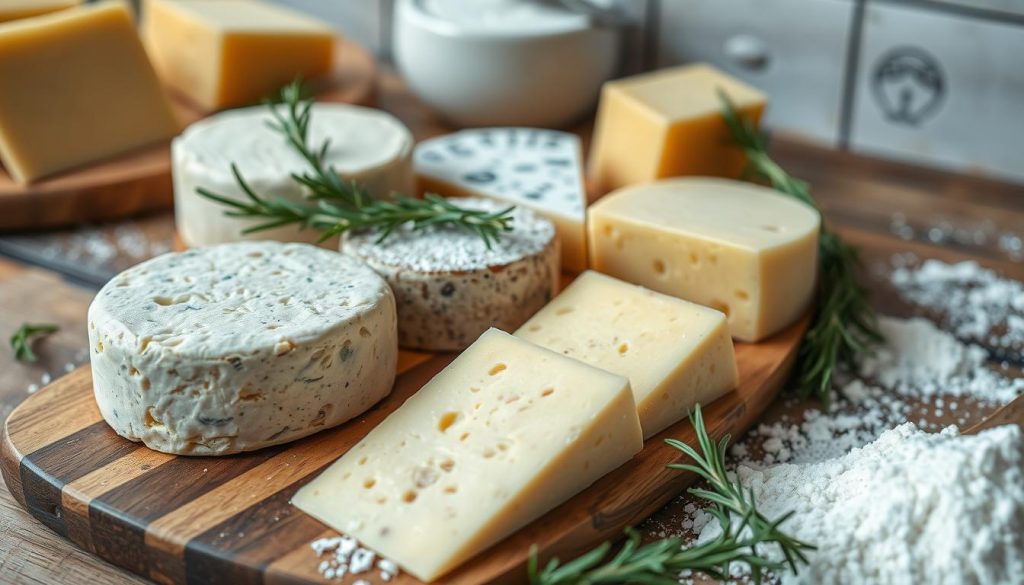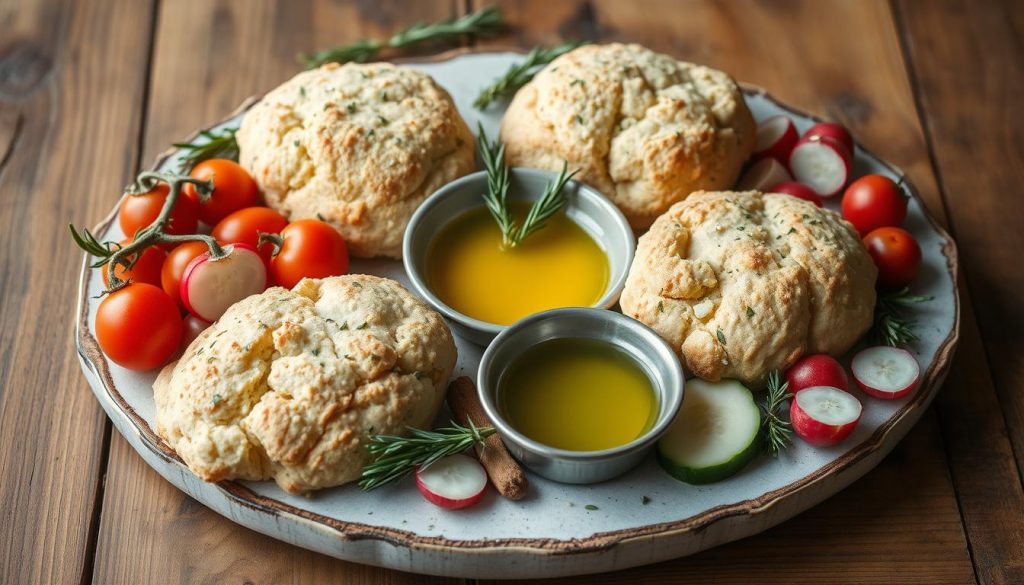Calling all baking enthusiasts! Get ready to turn your kitchen into a bakery. Today, I’m sharing a foolproof rosemary parmesan recipe. It will make your baking better and impress everyone.
Imagine pulling out golden, flaky scones full of fresh rosemary and parmesan cheese. These aren’t just treats – they’re a culinary adventure! This recipe will help you make restaurant-quality scones in your kitchen, no matter your skill level.
I’ve perfected this recipe through many experiments. Now, I’m excited to share my secrets with you. Get ready to fill your home with a delicious aroma and make a show-stopping bread that will be a favorite!
Grab your apron, preheat the oven, and let’s start making delicious homemade savory scones. Your taste buds will thank you!
Understanding the Magic of Homemade Rosemary Parmesan Scones
Explore the world of savory scones, where old traditions meet new baking ideas! Scones have changed from simple British tea snacks to versatile treats.
History of Savory Scones in Modern Baking
The story of savory scones is quite interesting. They started as sweet, delicate treats. But, in recent years, bakers have made them into something new. They added herbs and cheese, making them into fancy breads.
- Traditional Scottish origins in the 1500s
- Evolution from sweet to savory recipes
- Emergence of gourmet flavor combinations
Why This Recipe Works Every Time
My foolproof scone recipe is a hit with all bakers. It’s all about the right mix of ingredients and technique. The key is using the right amounts, keeping ingredients cold, and mixing just enough.
“Baking is a science, but scones are an art that anyone can master!” – Culinary Expert
| Scone Characteristic | Key Factors |
|---|---|
| Texture | Cold butter, gentle mixing |
| Flavor | Fresh herbs, quality cheese |
| Appearance | Proper shaping, egg wash |
By sticking to these tips, you’ll make rosemary parmesan scones that are always a hit. Get ready to take your baking to the next level!
Essential Ingredients for Perfect Savory Scones
Making amazing rosemary Parmesan scones begins with picking the best ingredients. Knowing each part’s role is key to making those flaky treats irresistible.
- Flour: Use unbleached all-purpose flour for the best texture
- Butter: High-quality, cold unsalted butter is a must
- Quality cheese for baking – aged Parmesan is best
- Fresh rosemary leaves
- Heavy cream
The secret to amazing scones is in your choice of ingredients. For Parmesan, go for aged cheese that’s at least 12 months old. This gives your scones a deep, nutty taste.
“Great baking is 50% ingredients, 50% technique, and 100% passion!” – Baking Enthusiast
Pro tip: Use ingredients at the right temperature. Cold butter and cream make scones flaky. Room temperature eggs help everything stick together.
| Ingredient | Quality Indicator |
|---|---|
| Parmesan Cheese | Aged 12-24 months, sharp flavor |
| Butter | High butterfat content, cold |
| Rosemary | Fresh, vibrant green, fragrant |
Baking is an art. Each ingredient is vital for a masterpiece that will wow your taste buds and impress guests!
Kitchen Tools and Equipment You’ll Need
Ready to turn your kitchen into a scone-baking haven? The right tools and equipment are key to a great baking experience. Let’s look at the essential gear for those irresistible rosemary Parmesan scones!
Before mixing and kneading, let’s check out the must-have baking tools for success.
Essential Scone Baking Tools
- Large Mixing Bowl: A sturdy, spacious bowl for combining ingredients
- Pastry Cutter: Key for creating perfect, flaky scone texture
- Baking Sheet: Preferably with a non-stick surface or lined with parchment paper
- Measuring Cups and Spoons: Precision is crucial in baking
- Sharp Knife or Bench Scraper: For cutting scone dough into perfect shapes
Optional Equipment for Enhanced Results
While not necessary, these tools can improve your scone-baking skills:
| Equipment | Benefit |
|---|---|
| Digital Kitchen Scale | Ensures precise ingredient measurements |
| Silicone Baking Mat | Provides even heat distribution and easy cleanup |
| Pastry Brush | Perfect for egg washing and adding extra shine |
| Cooling Rack | Prevents soggy bottoms by allowing air circulation |
“The right tools can turn a good baker into a great one!” – Baking Enthusiast
Don’t fret if you’re missing some items. Many tools are versatile and common in kitchens. What’s most important is your passion and enthusiasm for baking delicious homemade scones!
The Science Behind Flaky Scone Texture
Making the perfect scone is like a tasty science experiment in your kitchen! The secret to a flaky scone is knowing how ingredients and temperature work together.
Let’s look at the main parts of scone texture science:
- Butter’s crucial role in creating layers
- Gluten development and protein interactions
- Temperature control during preparation
- Mixing techniques that preserve texture
The key to a flaky scone is keeping ingredients cold and handling the dough gently. Cold butter is your best friend for making those layers. When cold butter meets the hot oven, it makes steam pockets. This is what gives scones their unique texture.
| Ingredient Factor | Impact on Texture |
|---|---|
| Cold Butter | Creates steam pockets and flaky layers |
| Minimal Mixing | Prevents gluten development and tough scones |
| Precise Temperature | Ensures even rise and perfect texture |
“Baking is a science, and scones are the delicious proof!” – Professional Baker’s Wisdom
Knowing these scientific tips makes you a scone texture expert. The main thing is to be precise, patient, and open to trying new things with your pastry.
Selecting and Preparing Fresh Rosemary
Fresh rosemary can turn simple recipes into amazing dishes. Knowing how to pick, store, and chop rosemary is key. It makes a big difference in your cooking.
Let’s explore how to work with this aromatic herb. It will take your rosemary parmesan scones to the next level!
Picking the Perfect Rosemary Sprigs
Here’s what to look for in fresh rosemary:
- Vibrant green color with no yellow or brown spots
- Firm, fragrant needles that spring back when touched
- Stems that feel flexible, not brittle
Smart Storage Strategies
Here are tips for storing fresh rosemary:
- Wrap loosely in slightly damp paper towels
- Place in a sealed plastic bag in the refrigerator
- Use within 7-10 days for maximum flavor
“The secret to incredible herb flavor is treating them with respect from selection to storage!” – Culinary Herb Experts
Chopping Techniques for Maximum Flavor
Here’s how to get the most out of rosemary:
- Use a sharp knife to prevent bruising
- Remove needles from stems by running fingers against the grain
- Chop finely for even distribution in your scones
- Avoid over-chopping, which can make the herb bitter
Pro tip: A sharp chef’s knife and a gentle touch are your best friends when preparing fresh rosemary!
Choosing the Right Parmesan Cheese

Finding the perfect parmesan is key for delicious rosemary parmesan scones. Not all parmesan cheese tastes the same. I’ll help you pick the best cheese for scones that will make your baking stand out!
Here’s what to look for in top-quality parmesan:
- Authentic Parmigiano-Reggiano from Italy
- Aged minimum 24 months for robust flavor
- Firm, granular texture
- Nutty and complex taste profile
Parmesan quality is very important in baking. Fresh, high-grade cheese turns simple scones into amazing dishes. Stay away from pre-grated cheese, as it often lacks flavor and may have additives.
“Great scones begin with exceptional cheese!” – Baking Enthusiast
Here’s a quick look at parmesan cheese grades:
| Grade | Aging Time | Flavor Intensity | Recommended Use |
|---|---|---|---|
| Standard | 12-18 months | Mild | Basic recipes |
| Premium | 24-36 months | Rich | Gourmet scones |
| Extra Aged | 36+ months | Intense | Special occasion baking |
Pro tip: Grate your parmesan fresh before mixing it into the dough. This keeps the flavor strong and gives you cheesy pockets in every bite!
Step-by-Step Mixing Method
Making the perfect scone is an art that starts with mastering the mixing technique. The secret to flaky, tender scones is in how you handle your ingredients. It’s all about care and precision.
Now, let’s explore the world of cold butter pastry. Every touch is crucial here!
Cold Ingredient Preparation
Exceptional scones begin with ice-cold ingredients. Here’s why:
- Cold butter creates steam pockets during baking
- Prevents butter from melting before cooking
- Ensures a light, flaky texture
Precise Dough Handling Techniques
“Treat your scone dough like a delicate dance partner – gentle, quick, and with minimal contact!”
When mixing your scone ingredients, follow these steps:
- Cut cold butter into small cubes
- Work quickly with fingertips
- Stop mixing when dough just comes together
| Technique | Key Benefit |
|---|---|
| Minimal Handling | Prevents gluten development |
| Cold Ingredients | Creates flaky layers |
| Quick Mixing | Maintains butter’s solid state |
With these techniques, you’ll turn simple ingredients into bakery-worthy delights!
Shaping and Cutting Techniques
Learning to shape scones is an art that turns simple dough into tasty treats. The right way to cut them can make a big difference. Here’s how to shape and cut your scone dough like a pro!
- Keep your work surface lightly floured
- Use a sharp knife or bench scraper for clean cuts
- Chill the dough before shaping for best results
Here are three classic scone shaping methods to try:
- Traditional Triangular Cut: Pat dough into a circular shape, then cut into 8 wedges like a pizza
- Round Scone Method: Use a biscuit cutter to create perfect circular scones
- Free-Form Rustic Style: Gently shape dough by hand for a more artisanal look
“The secret to perfect scones is handling the dough as little as possible!” – Professional Baker’s Tip
| Shaping Method | Pros | Best For |
|---|---|---|
| Triangle Cut | Quick and easy | Traditional scone lovers |
| Round Cutter | Uniform appearance | Bakery-style presentation |
| Free-Form | Rustic, homemade look | Relaxed baking style |
Pro tip when cutting scone dough: Dip your knife or cutter in flour between cuts to prevent sticking. This ensures clean, precise edges that will help your scones rise beautifully in the oven!
Best Practices for Baking Temperature and Time
Baking scones is an art that needs precision and care. The scone baking temperature is key to making delicious rosemary parmesan treats. Here are the essential guidelines to help you make bakery-perfect scones every time!
Getting the right oven temperature is crucial for those perfectly flaky, golden-brown scones. I’ll share my tried-and-true tips for baking success every time.
Oven Temperature Secrets
- Preheat your oven to 425°F (218°C) – this high temperature is key to creating that delightful crispy exterior
- Use an oven thermometer to ensure accurate temperature
- Place the rack in the middle of the oven for even heat distribution
How to Tell When Scones Are Done
Knowing when scones are done requires a bit of baking intuition. Here are some foolproof visual and tactile cues:
- Color Check: Look for a golden-brown exterior – this indicates perfect baking
- Touch Test: Gently press the top – it should feel firm but not hard
- Edges Indicator: The edges should be slightly darker and crisp
“The secret to perfect scones is watching them like a hawk during those crucial final minutes of baking!” – Passionate Home Baker
Pro tip: Baking time typically ranges between 12-15 minutes. Start checking at the 12-minute mark to prevent overcooking. Every oven is slightly different, so trust your senses and keep a close eye on those beautiful scones!
Storage and Freshness Tips
To keep your rosemary Parmesan scones delicious, use smart storage tips. I’ll share my top methods for storing and keeping scones fresh for days!
Cool-Down Process
First, let your scones cool completely on a wire rack. This step is key to avoid sogginess. Patience is key when storing baked scones!
Storage Options
- Room Temperature Storage
- Best for 1-2 days
- Store in an airtight container
- Line container with paper towel to absorb moisture
- Refrigerator Storage
- Extends freshness up to 5 days
- Wrap individually in plastic wrap
- Place in sealed container
Reviving Day-Old Scones
Want to revive scones beyond their first day? Try these quick tricks:
- Warm in oven at 300°F for 3-5 minutes
- Microwave for 10-15 seconds
- Brush with melted butter for extra moisture
“Fresh scones are a baker’s pride – and with these tips, every bite will taste like it just came out of the oven!” – Baking Pro
Freezing Tips
| Freezing Method | Storage Duration | Recommended Process |
|---|---|---|
| Unbaked Scone Dough | Up to 3 months | Wrap tightly, freeze on baking sheet |
| Baked Scones | Up to 2 months | Wrap individually, store in freezer bag |
By using these storage tips, your rosemary Parmesan scones will stay fresh and delicious. Enjoy them whenever you want a homemade treat!
Common Troubleshooting Solutions
Scone baking problems can happen to even the most experienced home bakers. Don’t worry – I’m here to help you navigate through the most common challenges and improve scone texture like a pro!
Baking the perfect scone is an art, and sometimes things don’t go exactly as planned. Let’s dive into some solutions that will transform your scones from disappointing to delectable.
Fixing Dense or Tough Scones
Nobody wants a scone that feels like a brick! Here are key reasons why your scones might be turning out dense:
- Overworking the dough: This is the number one culprit for tough scones. Mix just until ingredients come together
- Warm ingredients can make scones spread and lose their signature flakiness
- Using old or inactive baking powder reduces the scone’s ability to rise
“The secret to tender scones is handling the dough as little as possible!” – Professional Baker’s Wisdom
Addressing Flavor Balance Issues
When it comes to rosemary and parmesan scones, getting the right flavor balance is crucial. Too much herb can overpower, while too little leaves your scones bland.
- Finely chop fresh rosemary to distribute flavor evenly
- Use high-quality, freshly grated parmesan for maximum taste
- Start with smaller amounts of herbs and cheese, then adjust to your preference
Pro tip for improving scone texture: Always use cold butter and handle the dough minimally. Your scones will thank you with a light, flaky crumb that melts in your mouth!
Serving Suggestions and Pairings
Your freshly baked rosemary Parmesan scones deserve the perfect accompaniments! Let’s explore some delightful scone serving ideas that will elevate your culinary experience.

When considering what to eat with savory scones, I’ve discovered some mouthwatering pairings. These pairings will transform your simple bake into a gourmet meal.
Savory Companions
- Creamy herb butter
- Olive tapenade
- Roasted garlic spread
- Sun-dried tomato pesto
For a truly elegant spread, I recommend creating a small charcuterie board. This board should complement the robust flavors of your rosemary Parmesan scones.
| Pairing Category | Recommended Options |
|---|---|
| Spreads | Herbed cream cheese, fig jam |
| Proteins | Prosciutto, smoked salmon |
| Beverages | Crisp white wine, herbal tea |
“A perfect scone is a canvas waiting for delicious companions!” – Baking Enthusiast
Pro tip: Warm your scones slightly before serving. This will enhance their aromatic rosemary and Parmesan notes. The key is to create a balance that allows the scone’s unique flavor to shine through.
Quick Serving Suggestions
- Brunch centerpiece with soft scrambled eggs
- Appetizer with a light salad
- Afternoon tea accompaniment
- Picnic-friendly finger food
With these serving ideas, your rosemary Parmesan scones will become the star of any gathering!
Make-Ahead and Freezing Instructions
Want to enjoy fresh scones without daily baking? Freezing scone dough is your secret weapon! I’ll show you the best make-ahead scone tips to change your baking routine.
Preparing scones in advance is easier than you think. The trick is to freeze and store your dough right. This keeps the texture and flavor perfect.
Freezing Scone Dough: Step-by-Step Guide
- Prepare the scone dough as usual
- Shape the scones before freezing
- Place shaped scones on a baking sheet
- Freeze until solid (about 1-2 hours)
- Transfer to freezer-safe storage bags
When you’re ready to bake, no thawing needed! Just put the frozen scones in a hot oven. Thanks to make-ahead tips, you’ll have warm scones in 20 minutes.
| Freezing Method | Storage Time | Baking Instructions |
|---|---|---|
| Unbaked Dough | Up to 3 months | Bake from frozen, add 5-7 minutes to original baking time |
| Baked Scones | Up to 2 months | Thaw at room temperature, reheat in oven for 5-7 minutes |
“Freezing scone dough is like having a delicious backup plan in your freezer!” – Baking Enthusiast
Pro tip: Always wrap your scones tightly in plastic wrap or in airtight containers. This prevents freezer burn. Don’t forget to label with the date to keep track of freshness!
Recipe Variations and Adaptations
Ready to make your scone recipe your own? Let’s explore the world of culinary creativity! The basic rosemary parmesan scone recipe is super versatile. You can try different herbs, cheeses, and ingredients while keeping that flaky texture.
Adapting scone ingredients is a fun kitchen adventure. Swap rosemary for thyme or sage, and use sharp cheddar or creamy goat cheese instead of parmesan. For a Mediterranean flavor, add sun-dried tomatoes and crumbled feta. Need something special? Make gluten-free scones with almond flour or vegan scones with plant-based cheese and coconut cream.
Seasonal changes can make your scones even more special. In summer, add fresh corn kernels and chives. Autumn is perfect for roasted butternut squash and sage. Try nuts like toasted pine nuts or dried herbs for a deeper flavor. Each change brings a new taste, turning these scones into a canvas for your creativity.
Pro tip: When trying new scone recipes, keep the same liquid-to-dry ingredient ratio. This keeps your scones light and tender, no matter the flavors you mix. Be creative, have fun, and let your taste buds lead the way!



